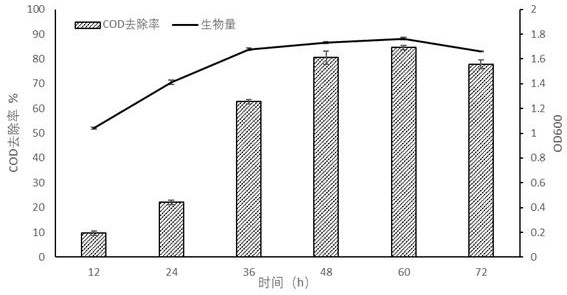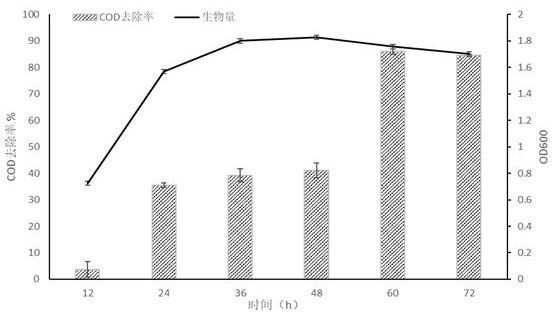Meyerozyma guilliermondii and method for treating high-salinity wastewater
A high-salt wastewater and yeast technology, applied in the direction of microorganism-based methods, seawater treatment, chemical instruments and methods, etc., can solve the problems of high cost and affect the production efficiency of processing plants, and achieve the effect of low cost and simple operation
- Summary
- Abstract
- Description
- Claims
- Application Information
AI Technical Summary
Problems solved by technology
Method used
Image
Examples
Embodiment 1
[0021] In the present invention, the bacterial strain capable of utilizing organic matter in high-salt wastewater is Pichia mongoliana ( Meyerozyma guilliermondii ), which has been deposited in the General Microbiology Center of the China Committee for the Collection of Microorganisms, code-named HSKeW-M, and the preservation number is CGMCC No.18675.
[0022] The method for processing high-salt wastewater with the above-mentioned Pichia quaternerii is carried out according to the following steps:
[0023] a. Gradually expand the cultivation of the above-mentioned Pichia mongolica (CGMCC No.18675) seed solution;
[0024] b. Add 8 times the volume of the expanded culture to the high-salt wastewater produced by kelp processing and the high-salt wastewater produced by wakame processing at a volume percentage of 5% respectively. Incubate for 60 hours.
[0025] The kelp processing high-salt wastewater and the wakame processing high-salt wastewater processed through the above meth...
Embodiment 2
[0027] The method for treating high-salt waste water with the above-mentioned Metchiella bitipina is carried out according to the following steps:
[0028] a. Combine the above-mentioned Pichia quaziermontii (CGMCC No.18675) with the preservation number of CGMCC No. Metschnikowia bicuspidate ) According to the volume ratio of 1:1, the composite seed solution is gradually expanded and cultivated;
[0029] b. Add 8 times the volume of the expanded culture to the high-salt wastewater produced by kelp processing at a volume percentage of 3%, and cultivate it on a shaker at 150 r / min for 60 hours at 20 °C.
[0030] The potassium permanganate oxidation method was used to measure the COD of the high-salt wastewater produced by kelp processing treated by the above method, and the results were as follows: image 3 shown. The results showed that the COD removal rate of high-salt wastewater produced by kelp processing was 85.98%.
PUM
 Login to View More
Login to View More Abstract
Description
Claims
Application Information
 Login to View More
Login to View More - R&D
- Intellectual Property
- Life Sciences
- Materials
- Tech Scout
- Unparalleled Data Quality
- Higher Quality Content
- 60% Fewer Hallucinations
Browse by: Latest US Patents, China's latest patents, Technical Efficacy Thesaurus, Application Domain, Technology Topic, Popular Technical Reports.
© 2025 PatSnap. All rights reserved.Legal|Privacy policy|Modern Slavery Act Transparency Statement|Sitemap|About US| Contact US: help@patsnap.com



